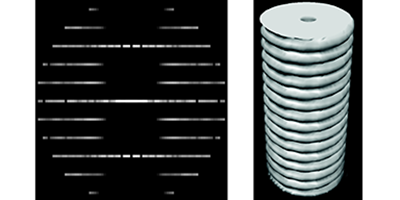No Need to Line Up
Fiber diffraction is a scattering technique that has been key to resolving the structure of some of the most important materials in nature, from DNA to helical viruses like the tobacco mosaic virus. A disadvantage of the technique is the need to line up large numbers of the molecules and arrange them into a fiberlike strand. This limitation could be overcome thanks to a new generation of powerful x-ray free-electron lasers (XFELs) that are starting to come online. A billion times brighter than a typical synchrotron beam line, XFELs could, in principle, image individual molecules with atomic resolution. The hitch is that to make these images, researchers would need to measure the diffraction patterns of many single molecules that were all prealigned along the same direction.
Researchers are exploring different alignment strategies, for instance, employing polarized laser beams, but according to a report in Physical Review Letters, this alignment step may not always be necessary. Hin-Cheuk Poon at the University of Wisconsin-Milwaukee and co-workers have proposed a method for determining the structure of molecules with helical symmetry (such as many viruses) by processing a series of diffraction patterns measured from randomly oriented particles. Using a computational trick, these patterns can be summed together to generate the same pattern that would be measured if the particles were arranged in a fiber bundle with perfect uniaxial symmetry. The final pattern could be more easily inverted to reveal the real molecular structure. The approach would potentially make it possible to solve the structure of a broad class of biological molecules through XFEL measurements. – Matteo Rini





